The Respiratory System
We rarely think about breathing unless we’re out of breath. The act of breathing is part of the respiratory system, a complex process where air travels into and out of the lungs.
Respiration is slightly different, where exercise causes muscles to release energy in the form of glucose. Both systems are co-dependent, especially when you’re playing sport and inhaling greater quantities of oxygen.
Human Respiratory System:
The human respiratory system is made up of air passages, lungs and the respiratory muscles. Nose: most breathing and gas exchange occur through the nose. It is lined by a layer of mucus and hair to trap the dust and germs in the air. It is also supplied with a dense network of blood capillaries to warm the air entering the body. Pharynx: Works together with the epiglottis to block the nasal cavity and the trachea during swallowing food, to prevent it from entering the respiratory system. Trachea (windpipe): this is a tube that connects the nasal cavity and larynx to the lungs. It is lined with a layer of ciliated epithelium cells and goblet cells which secrete mucus that traps bacteria and dust from inhaled air and gets moved upwards to the larynx by the cilia. |
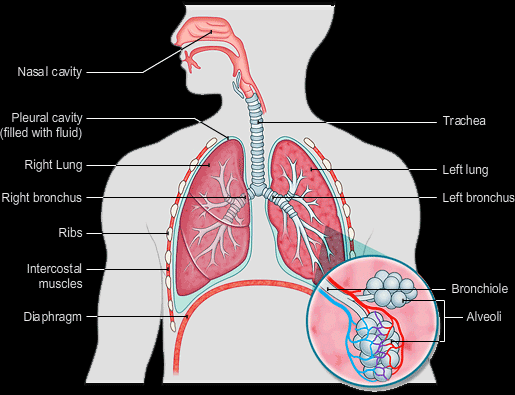 |
| It is then either spit out or swallowed to the stomach where it is eliminated by acid. | |
Bronchi: when the trachea reaches the lungs, it is divided into two tubes, one goes to the right lung and one goes to the left lung. These are called the bronchi. The bronchi are then divided bronchioles that extended deeper into the lungs.
Alveoli (air sacs): these are tiny bags full of gas; they are present in the lungs in large amounts (several million alveolus in each lung). They give the lungs a much larger surface area (about 70 m2) for faster diffusion of gases between them and the blood. Rib Cage: the lungs are protected by this cage of bones. It surrounds all the thoracic cavity. They are 12 pairs of ribs; one pair extends from one of the first 12 vertebrae of the vertebral column. All of the ribs except for the last two pairs are connected to the sternum, the chest bone. Each pair of ribs is connected to the pairs above it and below it by muscle fibres called inter costal muscles. The rib cage and the lungs are separated by an elastic layer called pleural membrane, or pleura for short. It protects the lungs from damage caused by friction with the rib cage during breathing. Diaphragm: this is a sheath of muscles that separates the thoracic cavity from the abdominal cavity. Together with the ribs and the inter costal muscles, it plays a big role in breathing and gas exchange. |
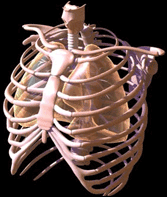 |
Gas Exchange (Breathing):
Breathing is different from respiration. Breathing is just the exchange of waste gases from the body with fresh air from the atmosphere. The action of breathing fresh air in is called inhaling; the action of breathing waste gases out is called exhaling.
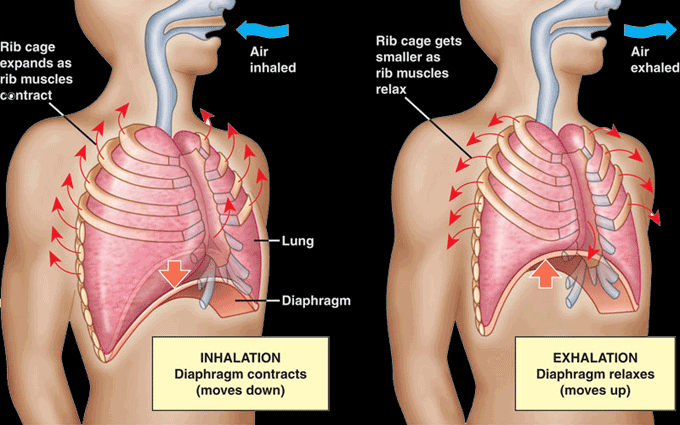
During Inhaling, the brain sends electric impulses by nerves to the diaphragm and the inter costal muscles. The diaphragm contracts becoming flatter. The inter costal muscles also contract and move the ribs in an outer upwards directions. These actions expand the thoracic cavity making the lungs expand, thus increasing the increasing the volume, with the volume increasing the internal pressure decreases which makes air enter the lungs through the mouth, nose and trachea.
During Exhaling, the diaphragm and the inter costal muscles relax again, contracting the thoracic cavity thus squeezing the air out of the lungs to the trachea and mouth and nose to the atmosphere.
Respiratory System in Action:
|
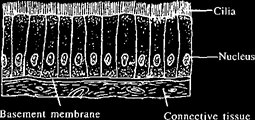 |
|
|
Gas Exchange in Alveoli:
Each alveolus is supplied with blood capillaries. These come from the pulmonary artery and they contain deoxygenated blood rich in carbon dioxide. The concentration of oxygen is very high inside the alveolus and very low in the blood, so oxygen molecules diffuse from the alveolus to the red blood cells and combine with haemoglobin. At the very same time this occurs, carbon dioxide diffuses from the blood to the alveolus because the concentration of it is very high in the blood and low in the alveolus.
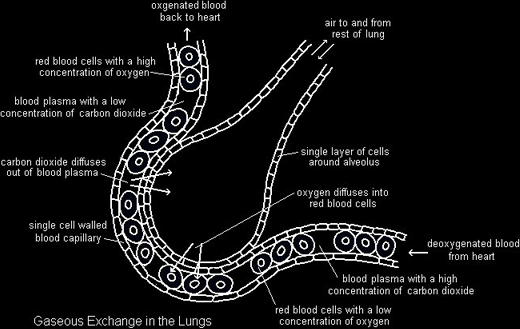
Adaptations of Alveoli:
Gas exchange happens because of several factors in the alveolus and the blood capillaries that control the rate of gas exchange:
- Very thin wall of both the alveolus and the capillary, they are one cell thick which makes the diffusion distance shorter, increasing the rate.
- The difference in concentration of gases between the alveolus and the capillary is very large, increasing the diffusion rate of gases.
- The alveolus are balloon shaped which gives it a very large surface area for faster diffusion.
- The walls of the alveolus are lined by a thin film of water in which gases dissolve in during diffusion, this makes it faster.
Composition of Inspired and Expired Air:
Gas |
Inspired Air |
Expired Air |
Oxygen |
21% |
16% |
Carbon Dioxide |
0.04% |
4% |
Nitrogen |
79% |
79% |
Water Vapour |
Variable |
High |
Lung Capacity:
When lungs of an adult are fully inflated they have a volume of about 5 litres.
Tidal Volume: This is the volume of air breathed in and out at rest, this is 0.5 litres.
Vital Volume: The maximum volume of air that can be breathed in and out, at exercise for example is 3 litres.
Residual Volume: The lungs have to have a certain volume of air inside them all the time to keep shape. This is the residual volume and it is 1.5 litres. This air is renewed through breathing.
Aerobic Respiration:
A chemical, metabolic reaction that burns down glucose with oxygen producing carbon dioxide, water vapour and lots of energy
Aerobic Respiration: the release of relatively large amounts of energy in cells by the breakdown of food substances in the presence of oxygen.
Anaerobic Respiration:
Some organisms are able to respire and release energy when oxygen is lacking. This is anaerobic respiration. These are like yeast, bacteria and other organisms. Humans can also respire anaerobically for a short period of time. The amount of energy produce is much smaller than that produced during aerobic respiration though.
Anaerobic respiration: the release of relatively small amount of energy by the breakdown of food substances in the absence of oxygen.
C6H12O6 (aq) + 6O2 (g) → 6 O2 (g) + 6H2O (l)
Anaerobic Respiration I Yeast: Yeast is able to respire anaerobically by breaking down glucose molecules into ethanol and carbon dioxide.
C6H12O6 → 2C2H5OH + 6CO2
Ethanol is produced here, so it is a fermentation reaction. Do remember that glucose is the only reactant.
Anaerobic Respiration in Humans:
When the amount of oxygen received by the muscle cells of the body is not enough to carry out all respiration aerobically, the cells respire anaerobically. But they cannot go like that for a long time. The anaerobic respiration in humans is different than of yeast. Lactic acid is produced instead of ethanol, and no carbon dioxide is produced.
C6H12O6 → 2C3H6O3
The lactic acid produced is very toxic and harmful to the body. That is why it has to be broken down with oxygen as soon as possible. This is called oxygen debt. Breaking down lactic acid releases energy too, if you add up the amount of energy produced during breaking down lactic acid and anaerobic respiration, you will find that it is the same as the amount produced during aerobic respiration.
Effects of Smoking:
Short Term Effects:
- Cilia can’t vibrate anymore, the air inhaled isn’t clean. Goblet cells release more mucus which makes the trachea narrower.
- Nicotine increases heart beat rate and blood pressure.
- Carbon monoxide combines with haemoglobin instead of oxygen combining with it.
- Carboxyhaemoglobin is formed which is stable.
- Less oxygen transported to cells.
Diseases Caused By Tar:
Chronic Bronchitis:
- Tar makes goblet cells in trachea produce excess mucus
- Mucus falls into lungs
- Bacteria in mucus breed causing infections like bronchitis
- The layer of excess mucus lining the walls of the alveoli increase the diffusion distance of gases making gas exchange slower
Emphysema:
- The excess mucus lining the alveoli irritates it, causing strong coughs which damage the alveoli.
- The alveoli lose its shape and surface area making gas exchange much slower.
- This cause short breathes and sounds while breathing.
Lung Cancer:
- When tar reaches the lungs, it is absorbed by cells of the bronchi, bronchioles and the lungs.
- The tar causes excessive division and reproduction of these cells which develops into cancer
- The cancer can be spread to other organs too.
Diseases Caused By Nicotine:
Coronary Heart Disease:
- Nicotine helps cholesterol deposition on walls of coronary arteries. This causes atheroma.
- Carbon monoxide also increases risk of blood clots forming which might results in blocking the artery.
- Less oxygen is delivered to heart cells, a heart attack or failure can take place leading to death.